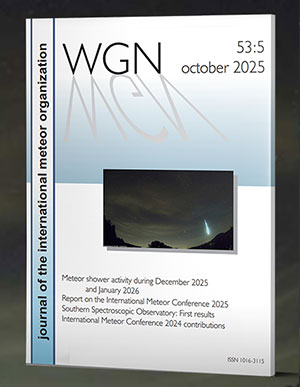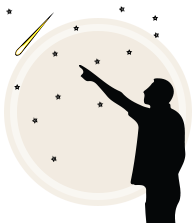Meteor rates continue to be strong as seen from
the northern hemisphere. The antihelion radiant has merged with the two Taurid
radiants producing slow meteors that are visible during the evening and early
morning hours. Swift meteors from the Leonid radiant can be seen during the
morning hours for two weeks centered at mid-month. Strong sporadic rates continue
during the morning hours as long as the moon is below the horizon. From the
southern hemisphere, sporadic rates are increasing in strength toward a peak in
January. Meteors from the Leonid and Taurid radiants also help to fill the
southern skies with more activity. A new moon during the peak of the Leonid shower
will help provide observers with dark skies.
This week the moon reaches its new phase on Monday
November 20. At this time the moon will lie close to the sun in the sky and will
not be visible at night. This will be the best time of the month to view meteor
activity. The estimated total hourly rates for evening observers this week is near
five for those north of the equator and three for observers south of the equator.
For morning observers the estimated total hourly rates should be near twenty five
for northern observers and fifteen for those south of the equator. These rates
assume that you are watching from rural areas away from all sources of light
pollution. The actual rates will also depend on factors such as personal light
and motion perception, local weather conditions, alertness and experience in
watching meteor activity.
The radiant positions listed below are exact for Saturday
night/Sunday morning November 18/19. These positions do not change greatly day to day
so the listed coordinates may be used during this entire period. Most star atlases
(available at science stores and planetariums) will provide maps with grid lines
of the celestial coordinates so that you may find out exactly where these positions
are located in the sky. A planisphere or computer planetarium program is also useful
in showing the sky at any time of night on any date of the year. Activity from each
radiant is best seen when it is positioned highest in the sky, either due north or
south along the meridian, depending on your latitude. It must be remembered that
meteor activity is rarely seen at the radiant position. Rather they shoot outwards
from the radiant so it is best to center your field of view so that the radiant
lies at the edge and not the center. Doing this will allow you to easily trace the
path of each meteor back to the radiant (if it is a shower member) or in another
direction if it is a sporadic. Meteor activity is not seen from radiants that are
located below the horizon. The positions below are listed in a west to east manner
in order of right ascension (celestial longitude). The positions listed first are
located further west therefore are accessible earlier in the night while those
listed further down the list rise later in the night.
These showers are expected to be active this week:
At this time of year debris from comet 2P/Encke produces a double radiant
very close to the position of the antihelion radiant. From now through the end of
November, it is impossible to resolve the antihelion meteors from those produced
by comet 2P/Encke. Therefore we suggest that observers simply classify meteors
from this area as either north or south Taurids.
The Northern Taurid (NTA) radiant is now centered at 04:20 (065) +24. This
position lies in northern Taurus, eight degrees east of the Pleiades star
cluster. The Southern Taurid (STA) radiant lies at 04:16 (064) +16. This
position lies in central Taurus, four degrees west of the first magnitude star
Aldebaran (Alpha Tauri). The two radiants are separated by eight degrees. Since they
have the same right ascension (celestial longitude), it is difficult to distinguish
meteors that move north or south out of the radiants. It is slightly less difficult
to distinguish those meteors traveling east or west.
These radiants are above the horizon most of the night and are best placed near
midnight LST, when they lie on the meridian and are located highest in the sky.
Rates at this time should be near two per hour for the southern radiant and three
per hour for the northern radiant, regardless of your location. With an entry
velocity near 30 km/sec., the average Taurid meteor would be of medium-slow speed.
Sirko Molau’s study of video radiants has revealed
activity during the period November 17-December 5, from an area in northeastern
Orion. Maximum activity occurs on November 28 with the radiant located at 06:04
(091) +15. This position lies one degree northwest of the fourth magnitude star
Nu Orionis. This radiant is best placed on the meridian near 0200 LST. It
appears that twelve percent of the total activity for the 28th is related to this
radiant. At 44km/sec., the average meteor from this radiant would be of medium
velocity. This activity has parameters quite similar to the Monocertoids, but is
a different shower as the video study also verified the Monocerotids with its
later activity period and more southerly radiant.
The Alpha Monocerotids (AMO) reach maximum activity on November 21 with
normally low rates of one or two shower members per hour. This shower has produced
outbursts in the past but none are expected for many years to come. The radiant
is located at 07:44 (116) +01. This position lies in southeastern Canis Minor,
three degrees southeast of the zero magnitude star Procyon (Alpha Canis Minoris).
These meteors are best seen near 0300 LST when the radiant lies highest above the
horizon in a dark sky. At 65 km/sec. the Alpha Monocerotids produce mostly
swift meteors.
The Leonids (LEO) will be best seen from November
17 through the 19th. The Earth passes closest to the node of comet Temple-Tuttle
late on the 17th (Universal Time). The best chance for enhanced activity will most
likely be near 0445 UT on the 19th. This timing favors Western Europe and northwestern
Africa. From the western hemisphere, northeastern South America and eastern North
America may see enhanced activity as the radiant rises in the east on Saturday
evening/Sunday morning November 18/19. No one knows exactly the strength of this
peak. Optimistic forecasters are predicting rates of 2-3 Leonids per minute for
a short time centered on the peak. Unfortunately these Leonids will most likely
be faint so those viewing from urban sites will not be able to see much at all.
Other locations than those mentioned above should watch for activity late in the
morning while the radiant is high on the dates mentioned above. The radiant is
located at 10:12 (153) +22. This position lies in northwestern Leo, just one degree
southwest of the third magnitude star Aldhafera (Zeta Leonis). The radiant rises
near 2300 (11:00pm) LST and is best placed in a dark sky just before the onset of
morning twilight. At 71km/sec., the average Leonid is swift.
Sporadic rates have reached the late year plateau
for observers located in the northern hemisphere. One would expect to see perhaps
sixteen random meteors during the last hour before dawn from rural observing sites.
During the first dark hour after the end of evening twilight, perhaps four random
meteors can be seen per hour. Sporadic rates increase as the night progresses so
rates seen near midnight would be near ten per hour. Sporadic rates seen from
the southern hemisphere have passed their annual minimum and are rising again.
One would expect to see approximately six random meteors per hour during the
last hour before dawn and two per hour during the first dark hour after the end
of evening twilight. Rates near midnight would be near four per hour.
| SHOWER | DATE OF MAXIMUM ACTIVITY | CELESTIAL POSITION | ENTRY VELOCITY | CULMINATION | HOURLY RATE | CLASS* | RA (RA in Deg.) DEC | Km/Sec | Local Standard Time | North-South | Northern Taurid (NTA) | Nov 12 | 04:20 (065) +24 | 29 | 00:00 | 3 – 3 | II | Southern Taurid (STA) | Nov 5 | 04:16 (064) +16 | 27 | 00:00 | 2 – 2 | II | Nu Orionids (NOR) | Nov 28 | 06:04 (091) +15 | 44 | 02:00 | 2 – 2 | IV | Alpha Monocerotids (AMO) | Nov 21 | 07:44 (116) +01 | 65 | 03:00 | 1 – 1 | III | Leonids (LEO) | Nov 19 | 10:12 (153) +22 | 71 | 06:00 | 15 – 10 | III |
Clear Skies!




 You saw something bright and fast? Like a huge shooting star? Report it: it may be a fireball.
You saw something bright and fast? Like a huge shooting star? Report it: it may be a fireball.  You counted meteors last night? Share your results with us!
You counted meteors last night? Share your results with us!  You took a photo of a meteor or fireball? You have a screenshot of your cam? Share it with us!
You took a photo of a meteor or fireball? You have a screenshot of your cam? Share it with us!  You caught a meteor or fireball on video? Share your video with us!
You caught a meteor or fireball on video? Share your video with us!